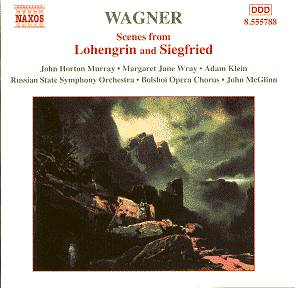This
enjoyable disc is a considerable curiosity. It is obviously intended
as a showcase disc for the German based American tenor, John Horton
Murray. Murray is currently making a name for himself in Strauss
roles, having been received with critical acclaim in the UK for
his Menelaus in ‘Die Frau ohne Schatten’ and Bacchus. In 2003/2004
he will be singing Lohengrin along with the Kaiser in ‘Die Frau
Ohne Schatten’, Bacchus and Florestan. The other singers are also
American; the talented young Margaret Jane Wray and the veteran
Adam Klein. Wray is also a promising singer, singing jugend-dramatisch
soprano roles. In 2003/2004 she will be singing Sieglinde, Chrysothemis,
the Prima Donna and Freya.
The
programme consists of Scenes 1 and 2 from Act Three of ‘Lohengrin’
coupled uneasily with Scene 3 from Act One of ‘Siegfried’. Recorded
in Moscow, the disc uses Russian forces conducted by another American,
John McGlinn who is best know in this country for his scholarly
work on and recordings of American musicals, pioneering performances
in their original scorings.
Regarding
the programming, it does seem odd that no further excerpts from
‘Lohengrin’ were recorded. Surely we could have heard more of
Murray’s Lohengrin. Given his fine performance in the two scenes
here, it is particularly galling that we have neither his farewell,
‘Mein lieber Schwann’, nor his entry (both items traditionally
excerpted in recitals). Additionally, it would have been nice
to hear more of Wray, perhaps in Elsa’s dream. There seems to
be no reason on earth to couple the Marriage scenes from ‘Lohengrin’
with the Forging scene from ‘Siegfried’. But all we can do is
listen and see if they are well done.
The
same is true of conductor, John McGlinn. Reputations are strange
things, and because he is best known in the UK for his work on
musicals, there is no reason in the world for him not to have
a wider profile in other countries. But still, it is surprising
too come across someone that you are used to conducting Kern and
Gershwin conducting Wagner.
Both
Wray and Murray have the jugend-dramatisch voices which are ideal
for ‘Lohengrin’. Able to cope with Wagner’s demands but able to
still bring to the roles an admirably ardency and youthful sheen.
Both sing with a fine sense of line, bringing much sense of legato
to bear. These are shapely performances; the singers do not simply
stand and bawl. But, I did wonder whether at the time of recording
(2001) Murray had actually sung the role in the opera house. There
is a lack of vividness in his attitude to the words and this is
rather shared by Wray. This is compounded by a feeling that the
emotions are rather generalised, not related in a detailed way
to Wagner’s words and music.
McGlinn
starts off with an impulsive and propulsive account of the Introduction.
The orchestra respond well to his speeds but the strings are a
little untidy in the busier passages. Judging by these two scenes,
McGlinn’s ‘Lohengrin’ is fully responsive to the origins of piece
in Italian opera. But his care does not seem to extend beyond
an individual number; the sense of Wagner’s over-arching structures
are rather lacking. But I am judging on the basis of 35 minutes
of music.
After
the ‘Lohengrin’ excerpts we must regrettably say goodbye to Wray’s
admirably firm and gleaming soprano. I do hope that I hear her
again soon, before she gets too tempted into singing the hoch-dramatisch
roles too early.
This
sense of doing hoch-dramatisch roles too early is one that occurs
again when listening to the scene from ‘Siegfried’. For most of
the scene, Murray is fully equal to the role, but towards the
end I became aware that he had no power reserves to draw on for
the final forging. Murray does make a believably youthful Siegfried.
Once a tenor has developed the reserves of power and stamina that
enable him to perform the whole of this terrific role, he has
often lost the ability to sound genuinely youthful. But I would
hope that Murray is not tempted to try a full ‘Siegfried’ for
some time yet.
As
Mime, Klein makes a good foil to Murray. More responsive to Wagner’s
words he seems to draw a more verbally aware performance from
Murray. John McGlinn and the orchestra provide fine support. But,
as with ‘Lohengrin’, I felt that performance moved from fine moment
to fine moment with the sense of the scene’s overall construction
lacking.
This
is an enjoyable disk and makes a reasonable showcase for the talents
of John Horton Murray, but a more coherent programme could perhaps
have made it something special.
Robert
Hugill
